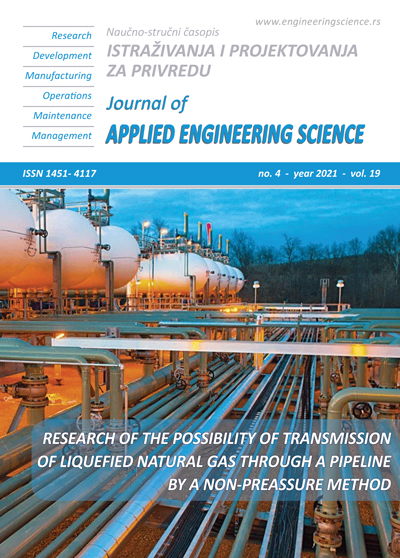DEVELOPMENT AND CHARACTERIZATION OF POLY(OXY-1,4-PHENYLENESULFONYL-1,4-PHENYLENE) FOR PROTON EXCHANGE MEMBRANES
Abstract
Proton Exchange Membranes (PEMs) are materials developed with a focus on high-performance, low-cost features to achieve promising fuel cell technology in stationary, portable, and transportation facilities. In this study, we synthesized membranes from Poly (oxy-1,4-phenylenesulfonyl-1,4-phenylene) (PES) sulfonated with modification by adding nanoclay to improve the mechanical properties of PEMs. The sulfonation time and the concentration of nanoclays directly favored properties such as contact angle, water absorption, porosity, and mechanical properties. However, a higher concentration of nanoclays (e.g., 10% by weight) damages the mechanical properties of PES membranes specifically. The membrane with 5% by weight of nanoclay and a sulfonation time of 2 h achieved the best performance.
References
1. ScienceDaily. Human influence on climate clear, IPCC report says, from http://www.sciencedaily.com/releases/2013/09/130927092341.htm, accessed on 2020-10-03.
2. IEA. International Energy Agency, Renewable Energy-Medium-term renewable energy market report 2015. Market analysis and fore- casts to 2020, from https://eef.se/wp-content/uploads/2017/10/MTRMR2015.pdf, accessed on 2020-10-03.
3. Priya, M., Muthukumaran, B. (2015). Enhanced performance an ethanol membraneless fuel cell in acidic medium. International Journal of ChemTech Research, vol. 7, no.7, 3026–3032.
4. Li, Q., Jensen, J.O., Savinell, R.F., Bjerrum, N.J. (2009). High temperature proton exchange membranes based on polybenzimidazoles for fuel cells. Progress in Polymer Science, vol. 34, no, 5, 449-477, DOI: 10.1016/j.progpolymsci.2008.12.003.
5. Alaswad, A., Palumbo, A., Dassisti, M, Olabi, A.G. (2016). Fuel Cell Technologies, Applications, and State of the Art. A Reference Guide. Reference Module in Materials Science and Materials Engineering, DOI: 10.1016/B978-0-12-803581-8.04009-1.
6. Realpe-Jiménez, Á., Pino, Y., Acevedo, M.T. (2016). Development of sulfonated latex membranes and modified with Va2O5 for application in PEM fuel cells. International Journal of ChemTech Research, vol. 9, no. 11, 157–163.
7. Realpe-Jiménez, A., Méndez, N., Toscano, E., Acevedo, M. (2015). Síntesis y Caracterización Fisicoquímica de una Membrana Cargada con TiO2 Preparada a Partir de la Sulfonación de un Copolímero de Éster Acrílico y Estireno. Información Tecnológica, vol. 26, no. 5, 97–104.
8. Realpe-Jiménez, A., Pino, Y., Acevedo-Morantes, M. (2015). Synthesis of a proton exchange membrane obtained from sebs copolymer for application in a fuel cell. International Journal of Applied Engineering Research, vol. 10, 15905–15913.
9. Realpe-Jiménez, A., Barrios, K., Acevedo-Morantes, M. (2015). Proton exchange membranes with titanium dioxide prepared by sulfonation of rubber. International Journal of Applied Engineering Research, vol. 10, 5023–5030.
10. Durán, J.D.G., Ramos-Tejada, M.M., Arroyo, F.J., González-Caballero, F. (2000). Rheological and electrokinetic properties of sodium montmorillonite suspensions: I. Rheological properties and interparticle energy of interaction, Journal of Colloid and Interface Science, vol. 229, pp. 107–117, DOI: 10.1006/jcis.2000.6956.
11. Mokrini, A., Acosta, J.L. (2001). Studies of sulfonated block copolymer and its blends. Polymer, vol. 42, no. 1, 9–15, DOI:10.1016/S0032-3861(00)00353-0.
12. Ibrahim, A., Hossain, O., Chaggar, J., Steinberger-Wilckens, R., El-Kharouf, A. (2019). GO-nafion composite membrane development for enabling intermediate temperature operation of polymer electrolyte fuel cell. International Journal of Hydrogen Energy. DOI:10.1016/j.ijhydene.2019.05.210.
13. Saedi S., Madaeni, S.S., Shamsabadi, A.A. (2014). Fabrication of asymmetric polyethersulfone membranes for separation of carbon dioxide from methane using polyetherimide as polymeric additive, Chemical Engineering Research and Design, vol. 92, no. 11, 2431-2438, DOI: 10.1016/j.cherd.2014.02.010.
14. Dai H., Guan, R., Li, C., Liu, J. (2007). Development and characterization of sulfonated poly(ether sulfone) for proton exchange membrane materials, Solid State Ionics, vol. 178, no. 5–6, 339-345, DOI: 10.1016/j.ssi.2006.09.013.
15 Ghaemi, N., Madaeni, S. S., Alizadeh, A., Rajabi, H., & Daraei, P. (2011). Preparation, characterization and performance of polyethersulfone/organically modified montmorillonite nanocomposite membranes in removal of pesticides. Journal of Membrane Science, 382(1–2), 135–147
16. Arroyo, D., Ochoa, J. (2017). Obtención de material compuesto de copolímero de bloque estireno-etileno-butadieno-estireno (SEBS) con nanoarcilla para la determinación de su estabilidad física. Universidad de Cartagena, Colombia.
17 Fernandez, M., & Patrón, J. (2016). Evaluación fisicoquímica y mecánica de los efectos de la adición de nanoarcillas sobre la estabilidad química del copolímero estireno-etileno-propileno-estireno (SEPS). Universidad de Cartagena, Colombia.
18. Raja Rafidah R. S., Rashmi W., Khalid M., Wong W.Y., Priyanka J. (2020). Recent Progress in the Development of Aromatic Polymer-Based Proton Exchange Membranes for Fuel Cell Applications, Polymers, vol. 12, 1061, DOI:10.3390/polym12051061.
19. Klaysom, C., Ladewig, B. P., Lu, G. Q. M., Wang, L. (2011). Preparation and characterization of sulfonated polyethersulfone for cation-exchange membranes. Journal of Membrane Science, vol. 368, no. 1-2, 48-53, Doi:10.1016/j.memsci.2010.11.006
20. Radmanesh, F., Rijnaarts, T., Moheb, A., Sadeghi, M., De Vos, W. M. (2019). Enhanced selectivity and performance of heterogeneous cation exchange membranes through addition of sulfonated and protonated Montmorillonite. Journal of Colloid and Interface Science, 533, 658-670.
21. Abderezzak, B. (2018). Introduction to Hydrogen Technology. Introduction to Transfer Phenomena in PEM Fuel Cell, 1–51. DOI:10.1016/b978-1-78548-291-5.50001-9.
22. González-Trujillo, Y.F., Vargas-Zapata, R.A. (2011). Estudio de las propiedades termodinámicas y eléctricas de materiales compuestos poliméricos basados en el Poli (Vinil Alcohol) (PVA) + H3PO2 + TiO2. Revista Iberoamericana de polímeros, vol. 12, no. 2, 64-75.
23. Ureña, N., Pérez-Prior, M., del Río, C., Várez, A., Sanchez, J., Iojoiu, C., Levenfeld, B. (2019). Multiblock copolymers of sulfonated PSU/PPSU Poly(ether sulfone)s as solid electrolytes for proton exchange membrane fuel cells. Electrochimica Acta, vol. 302, 428-440, DOI: 10.1016/j.electacta.2019.01.112.
24. Mosa, J., Durán, A., & Aparicio, M. (2007). Membranas híbridas basadas en estireno-metacrilato-sílice y ácido fosfowolfrámico obtenidas por solgel para pilas de combustible de intercambio protónico (PEMFC). Boletín de la Sociedad Española de Cerámica y Vidrio, 46(5), 267-272.

